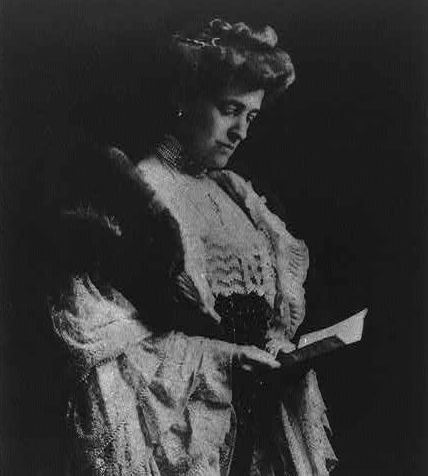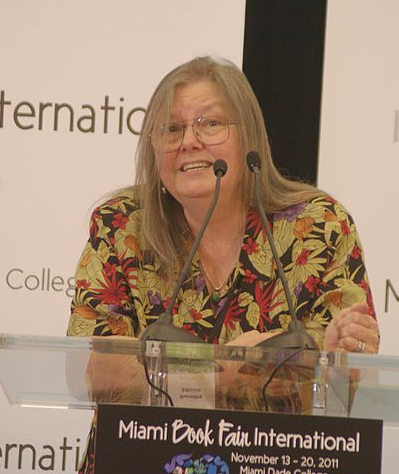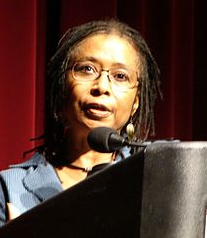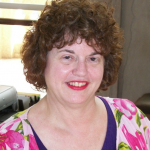TW Column by Emily Toth
“I've Got to Make Up!”
At five, Edith Jones knew she had the storytelling jones. Sometimes she’d be sitting demurely and the urge would hit. “Mamma, you must go and entertain that little girl for me. I've got to make up!” She’d run to her room and start declaiming, shouting out the stories that were welling up inside her.
 Once she learned how to write, she got quieter, but the creative frenzy never left. She wound up scribbling endlessly on stolen butcher paper.
Once she learned how to write, she got quieter, but the creative frenzy never left. She wound up scribbling endlessly on stolen butcher paper.
Even as a child, Edith had the unique, driving faith that writing matters. No one else in her family had it. They were most famous for being filthy rich, and everyone else was supposed to keep up with the Joneses. Edith grew up, married properly, and was desperately miserable—until, in her thirties, as Edith Wharton, she rediscovered writing. She never looked back.
Every woman who writes needs tremendous faith in her own gifts—and a passionate will to tell her own story, to get it out. Dorothy Allison, growing up poor in a mean and brutal household, would run away to take long walks, making up stories—the seeds of her novel Bastard Out of Carolina, a 1992 National Book Award finalist, and the short stories of Trash.
“Women run away because they must. I ran because if I had not, I would have died,” Allison writes in her 1995 memoir Two or Three Things I Know for Sure. And:
Making up the story as you went along was the way to survive.
 Where does that writing drive come from? I’ve always had it, even though I had a happy childhood. I’ve always been an introvert, a secret scribbler with a “What if?” imagination. Sometimes I give “the exact truth” a lot more frills and frissons. Writers do that—which annoys the hell out of adults around them.
Where does that writing drive come from? I’ve always had it, even though I had a happy childhood. I’ve always been an introvert, a secret scribbler with a “What if?” imagination. Sometimes I give “the exact truth” a lot more frills and frissons. Writers do that—which annoys the hell out of adults around them.
It’s the story of women’s lives, especially the lives of female writers. Erica Jong’s breezy narrator in Fear of Flying, Isadora Wing, has a sister who scoffs at her for “farting around with poetry.” An almost-mother-in-law broke off Edith Jones’s first engagement because of “alleged preponderance of intellectuality on the part of the intended bride”—and her own mother considered making up stories to be useless and infantile. Young women aren’t supposed to follow their own ambitions, to tell their own stories.
That could be why, among the canonical American writers whose careers I've tracked in an ongoing study, the men mostly published their first novels when they were 26. Women were rarely published before they were 32. Women had to fight harder.
There are moms, though, who’ve believed in their daughters’ gifts. Nora Ephron’s screenwriter mother was, by Ephron’s account, more than a little loony. But she drilled her writer daughters with the now famous line, “Everything is copy.” On her deathbed, she gave orders: “Take notes.”
 Mothers also hand on “the creative spark” in other ways, writes Alice Walker in her 1983 essay collection In Search of Our Mothers’ Gardens. They share “the seed of the flower they themselves never hoped to see.” Alice was eight when she was shot in the eye by a B. B. gun. It was 1952—before the civil rights movement, before Rosa Parks—and there was no medical treatment for the children of poor black Georgia sharecroppers. She comforted herself with stories; her mother, a domestic, scrimped and saved. For Alice’s birthday, her mother bought her a typewriter—the “magic gift” that opened the world.
Mothers also hand on “the creative spark” in other ways, writes Alice Walker in her 1983 essay collection In Search of Our Mothers’ Gardens. They share “the seed of the flower they themselves never hoped to see.” Alice was eight when she was shot in the eye by a B. B. gun. It was 1952—before the civil rights movement, before Rosa Parks—and there was no medical treatment for the children of poor black Georgia sharecroppers. She comforted herself with stories; her mother, a domestic, scrimped and saved. For Alice’s birthday, her mother bought her a typewriter—the “magic gift” that opened the world.
Grace DeRepentigny, a poor Franco-American child during the Great Depression, used to hunker down in her aunt’s bathtub to make up stories (“I’ll be out soo-oon,” she’d promise—then keep writing). Grace married George Metalious, had three children, hated being a housewife, and wrote and wrote and wrote, typewriter on her lap because they were too poor to buy a table. Grace Metalious’s first publication, when she was 32, was the scandalous bestseller Peyton Place. Her life changed forever.
“A woman who writes feels too much,” Anne Sexton warned in her poem “The Black Art.” But a woman who writes also needs to keep that fierce faith in her own stories. Sometimes writers do give up. After Margaret Mitchell published Gone with the Wind at age 36, she spent the rest of her life answering letters from friends and family and fans. She’d written the one big story she felt driven to write.
Metalious drank herself to death before she was 40; Sexton, 32 when she published her first book, took her own life at 45.
But others have lived long and prospered. Wharton was working on her most upbeat, cheerful novel, The Buccaneers, when she died at 75. Ephron was working on a jaunty play, Lucky Guy, when she died at 71. Allison (64), Walker (69), and Jong (71) are all still writing.
“If you don’t risk anything, you risk even more,” wrote Jong in Fear of Flying decades ago.
Writers mostly don’t retire—which brings me to Alice Munro, who thought she was quitting the field last July. She was 82. She'd been writing since she was "about twenty," Munro told interviewer Adam Smith, "but that's a long time to be working, and I thought maybe it's time to take it easy."
When she first announced that she was going to stop writing, I remember thinking she didn’t have the fire in the blood anymore, the urgent belief in the stories that had to be told. Then, this past October, Munro won the Nobel Prize for Literature.
Was she still going to stop writing? Smith asked her after the award was announced, as part of a phone interview for the Nobel Prize website.
Well, she admitted, “this may change my mind.”
Publishing Information
- Edith Wharton’s “I've got to make up!” is from her autobiography A Backward Glance, originally published in 1933 by The Curtis Publishing Co. (Simon & Schuster, 1998).
- Two or Three Things I Know for Sure by Dorothy Allison (Plume/Penguin, 1995).
- Fear of Flying by Erica Jong, originally published in 1973 by Holt, Rinehart and Winston (Signet/Penguin, 2003, fortieth anniversary edition).
- Wharton’s almost mother-in-law’s reference to the “alleged preponderance of intellectuality on the part of the intended bride” is from Edith Wharton: A Biography by R. W. B. Lewis (HarperCollins, 1975).
- In Search of Our Mothers’ Gardens: Womanist Prose by Alice Walker, essay originally published in 1974 in Ms. (Harcourt, 1983).
- Inside Peyton Place: The Life of Grace Metalious by Emily Toth, originally published by Doubleday in 1981 (University Press of Mississippi, 2000).
- “The Black Art” by Anne Sexton in All My Pretty Ones, originally published in 1962 by Houghton Mifflin and in The Complete Poems: Anne Sexton (Houghton Mifflin, 1981).
- “Alice Munro—Interview” by Adam Smith for NobelPrize.org, October, 10, 2013.
Art Information
- "Edith Wharton"; Courtesy Library of Congress; public domain.
- "American Writer Dorothy Allison at the Miami Book Fair International 2011" © Rodrigo Fernández; Creative Commons license.
- "Erica Jong Visiting Barnes & Noble in New York" (2013) © Wes Washington; Creative Commons license.
- "Alice Walker" (2007) © Virginia DeBolt; Creative Commons license.
- "Alice Walker, Miami Book Fair International, 1989" © MDCarchives; Creative Commons license.
 Emily Toth is a contributing writer at Talking Writing, where her column “Nothing but the Toth” appears regularly. She also writes the Ms. Mentor online advice column for the Chronicle of Higher Education.
Emily Toth is a contributing writer at Talking Writing, where her column “Nothing but the Toth” appears regularly. She also writes the Ms. Mentor online advice column for the Chronicle of Higher Education.
Emily reports that she was one of the "victors" of NaNoWriMo this past November, during which she wrote a novel in just one month. Congratulations to one of our favorite writers!
